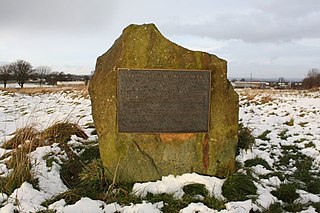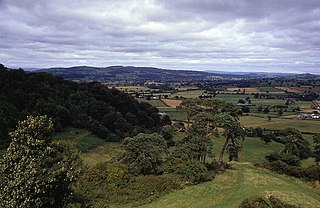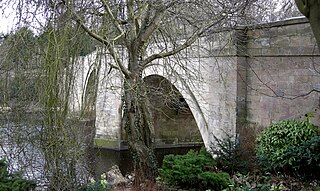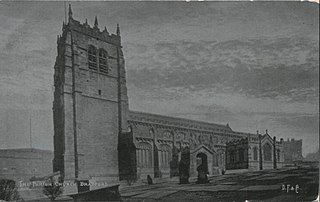
The Battle of Marston Moor was fought on 2 July 1644, during the Wars of the Three Kingdoms of 1639–1653. The combined forces of the English Parliamentarians under Lord Fairfax and the Earl of Manchester and the Scottish Covenanters under the Earl of Leven defeated the Royalists commanded by Prince Rupert of the Rhine and the Marquess of Newcastle.
The Battle of Nantwich was fought on 25 January 1644 in Cheshire during the First English Civil War. In the battle, Sir Thomas Fairfax in command of a Parliamentarian relief force defeated Lord Byron and the Royalists.

The Second Battle of Newbury was a battle of the First English Civil War fought on 27 October 1644, in Speen, adjoining Newbury in Berkshire. The battle was fought close to the site of the First Battle of Newbury, which took place in late September the previous year.

The Battle of Adwalton Moor occurred on 30 June 1643 at Adwalton, West Yorkshire, during the First English Civil War. In the battle, the Royalists loyal to King Charles led by the Earl of Newcastle soundly defeated the Parliamentarians commanded by Lord Fairfax.

The siege of York in 1644 was a prolonged contest for York during the First English Civil War, between the Scottish Covenanter army and the Parliamentarian armies of the Northern Association and Eastern Association, and the Royalist Army under the Marquess of Newcastle. It lasted from 22 April until 1 July when the city was relieved by Prince Rupert of the Rhine. Rupert and Newcastle were defeated the next day at the decisive Battle of Marston Moor, and the siege resumed until the city was surrendered on easy terms on 16 July.

The Battle of Gainsborough took place during the First English Civil War on 28 July 1643. The strategically important town of Gainsborough, Lincolnshire, was a Royalist base used for harassing the Parliamentarians who were generally dominant in Lincolnshire, but was taken by Parliamentarians in July 1643. An attempt to recapture Gainsborough by Charles Cavendish and the Royalists was foiled in a battle in which Colonel Oliver Cromwell distinguished himself as a cavalry leader.

The Second Battle of Middlewich took place on 26 December 1643 near Middlewich in Cheshire during the First English Civil War. A Royalist force under Lord Byron defeated a Parliamentarian army commanded by Sir William Brereton.
The Battle of Seacroft Moor took place in Whinmoor moor near the village of Seacroft, north-east of Leeds in West Riding on 30 March 1643 during the First English Civil War. In the battle, a Parliamentarian force commanded by Lieutenant-General Thomas Fairfax was decisively beaten by a Royalist cavalry force commanded by George Goring.
The Battle of Aldbourne Chase was a relatively small battle of the First English Civil War that occurred on 18 September 1643. In the skirmish the Royalist cavalry led by Prince Rupert attacked the extended columns of the Parliamentarian army of the Earl of Essex at Aldbourne Chase, Wiltshire, as he was attempting to get his army to London.
The unsuccessful second siege of Hull by the Royalist Earl of Newcastle in 1643 was a victory for Parliament at the high point of the Royalist campaign in the First English Civil War. It led to the abandonment of the Earl of Newcastle's campaign in Lincolnshire and the re-establishment of Parliament's presence in Yorkshire.
The Battle of Selby occurred on 11 April 1644 in North Yorkshire during the First English Civil War. In the battle, the Parliamentarians led by Lord Fairfax attacked and captured the strategic Royalist garrison of Selby under the command of John Belasyse.

The Battle of Burton Bridge was fought between Royalist and Parliamentarian forces at Burton upon Trent on 4 July 1643 during the First English Civil War. By the time of the battle, the town, which had at various times been held by both sides, was garrisoned by a Parliamentarian unit under the command of Captain Thomas Sanders and the town's military governor, Colonel Richard Houghton. The key river crossing at Burton was desired by Queen Henrietta Maria, who was proceeding southwards from Yorkshire with a convoy of supplies destined for King Charles I at Oxford. The Royalists, led by Colonel Thomas Tyldesley, launched a cavalry charge across the bridge which succeeded in defeating the Parliamentarians and capturing most of their officers, including Sanders and Houghton. The Queen's convoy proceeded on its way south to Oxford, with Tyldesley receiving a knighthood and a promotion in recognition of his victory. Burton changed hands several more times during the course of the war, before finally coming under Parliamentarian control in 1646.
This is a timeline for the English Civil War in Shropshire.

The Battle of Montgomery took place during the First English Civil War of 1642–1646. On 17 September 1644, a Parliamentarian force commanded by Sir John Meldrum advanced to engage a Royalist army led by Lord Byron which was besieging Montgomery Castle in mid Wales. The battle was fought the next day. After the Royalists gained an initial advantage, the Parliamentarians counter-attacked and destroyed Byron's army.
The battle of Leeds took place during the First English Civil War on 23 January 1643, when a Parliamentarian force attacked the Royalist garrison of Leeds, Yorkshire. The attack was partly dictated by the need to maintain local support for the Parliamentarian cause; the Earl of Newcastle had recently shifted the balance of power in Yorkshire in the Royalists' favour with the addition of his 8,000-strong army, and sent one of his commanders, Sir William Savile to capture Leeds. The West Riding of Yorkshire relied on the cloth trade, and Ferdinando, Lord Fairfax sent his son, Sir Thomas Fairfax to bolster the defences of nearby Bradford, before agreeing to his request to attack Leeds.

The capture of Wakefield occurred during the First English Civil War when a Parliamentarian force attacked the Royalist garrison of Wakefield, Yorkshire. The Parliamentarians were outnumbered, having around 1,500 men under the command of Sir Thomas Fairfax, compared to the 3,000 led by George Goring in Wakefield. Despite being outnumbered, Parliamentarians successfully stormed the town, taking roughly 1,400 prisoners.
The Battle of Tadcaster took place during the First English Civil War on 7 December 1642, when a Royalist force attacked the Parliamentarian garrison of Tadcaster, Yorkshire, which was held by between 900 and 1,500 soldiers under the command of Ferdinando Fairfax, Lord Fairfax. The Earl of Newcastle marched out of York on 6 December, and split his force of 6,000 into two; he took 4,000 infantry down the main York–Tadcaster road to attack the town from the east, while sending a deputy, the Earl of Newport, with a further 1,500 to circle around and trap the Parliamentarians by attacking from the north-west.

The battle of Piercebridge was fought on 1 December 1642 in County Durham, England, during the First English Civil War. The Earl of Newcastle was advancing with an army of 6,000 from Newcastle upon Tyne to York to reinforce the local Royalists. Aware of his approach, the Parliamentarians defended the main crossing over the River Tees, at Piercebridge. Under the command of Captain John Hotham, around 580 troops had barricaded the bridge.

The sieges of Bradford, were two very short-lived sieges that took place separately in the town of Bradford, Yorkshire, in December 1642 and early July 1643, just after the Royalist victories in Pontefract (1642), and the Battle of Adwalton Moor (1643) respectively. In the second siege, with the Parliamentarian forces dispersed to the west in and around Halifax, the Earl of Newcastle subjected Bradford to a brief siege to enforce rule and allegiance to the king.
The Battle of Sherburn in Elmet was an action fought towards the end of the First English Civil War. A detachment of the English Royalist army led by Lord Digby, King Charles I's Secretary of State, was making a belated attempt to reach Scotland and join forces with the Scottish Royalists. As they moved north through Yorkshire, they were pursued by a Parliamentarian force under Sydnam Poyntz. Poyntz was unaware of the Royalists' position, and the Royalists took the opportunity to ambush and attack a small Parliamentarian detachment at night in the village of Sherburn in Elmet. However, the Royalists then mistook fleeing Parliamentarians for their own men and panicked. In the ensuing flight, several hundred Royalist prisoners were taken. The Parliamentarians also captured Digby's coach, which contained much compromising correspondence.












